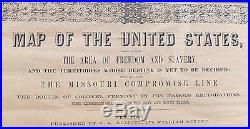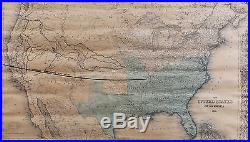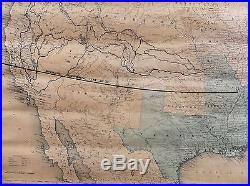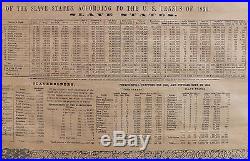1856 Fremont U. S. Missouri Compromise Map & Slave Statistics By G. W. Elliott













It has portraits of Republican President and Vice President candidates Colonel J. Dayton beside the title "Map Of The United States, The Area Of Freedom And Slavery, And The Territories Whose Destiny Is Yet To Be Decided; Exhibiting Also The Missouri Compromise Line". The sub title is The Routes Of Colonel Fremont In His Famous Explorations. With Important Statistics Of The Free And Slave States.
This 1856 map was Published By G. Elliott, 172 Willian Street New York. Published as Republican campaign material, the map has a bold black line to show the Missouri Compromise demarcation and also distinguished the different status of the states and territories with reference to slavery.
Despite the fact that Fremont and Dayton lost the election, these different maps related to the Kansas-Nebraska Act played an important and fascinating role in American history between 1854 and 1856. In, possibly, it's original black wood frame the map measures 32 1/2" X 29 3/8" X 3/4 and weighs 9 pounds 10 ounces. We find this in extraordinary condition for it's age and history. The map has darkened and there are some ripples in the paper.
There is a repair of a 4 1/2" tear at the top between "United" and "States. There are some wrinkles at the bottom, most noticeable in the Slaveholders report. The heavy frame could use some restoration. This is from the estate of an elegant Montecito matron who had a wonderful collection of rare maps and books. You may enjoy viewing my other listings at this time...I will be happy to answer any questions and/or send more pictures. Often, Greyhound has the best rates. Just a bit more history: Republicans used maps extensively to advance their cause in the 1850s.
In January of 1854, Stephen Douglas introduced a bill to transform what had been permanent Indian country into two new territories of Kansas and Nebraska. Douglas added a proviso allowing the future residents to determine the existence of slavery in the region, which overturned the longstanding geographical separation between slave and free territory mandated by the Missouri Compromise of 1820 along the line of 36 30 that is marked on the map. Douglas introduced the bill for several reasons, but mostly to cultivate the support of southern Democrats who worried that the future of slaveryand of slave state representationwas blocked by the Missouri Compromise. But his decision to repeal the Compromise outraged northerners in a way that can hardly be overestimated. They defected from the Democrats and Whigs to form what eventually became the Republican Party, dedicated to halting the extension of slavery.The item "1856 Fremont U. Missouri Compromise Map & Slave Statistics By G. Elliott" is in sale since Sunday, March 06, 2016.
This item is in the category "Antiques\Maps, Atlases & Globes\United States (Pre-1900)\Entire US". The seller is "oz5477" and is located in Summerland, California.This item can be shipped worldwide.
- Condition: Used
- Type: Map
- Maker: G.
